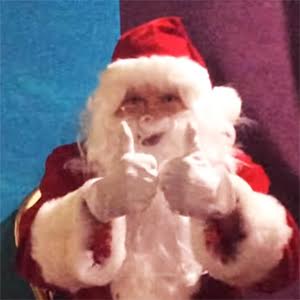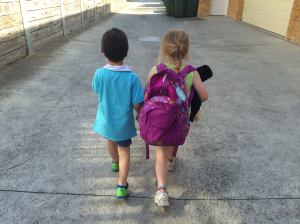
Do you have anything in beige?
When my daughter Amelia was nearly two and a half, we had her first appointment to be fitted for hearing aids. It’s a big milestone day that one, making the cutting of teeth and other family firsts seem trivial by comparison.
This event was the start of something scary and new, from which there was no turning back. In the two months prior to her deafness being diagnosed, we’d floated anxiously in the no-man’s-land between knowledge and action.
We knew Amelia was deaf but nothing else changed in the weeks that followed. The news just didn’t feel real until the post-diagnosis machinery cranked into gear and Amelia received her hearing aids.
I remember the trepidation I felt, the anxiety that hovered behind me during all of those initial ‘big’ appointments like a dark shadow.
How would we get Amelia to sit still for the mould impressions to be taken? Would we remember all of the instructions given to us?
Thankfully, everything went smoothly and our girl sat statue-like while a strange green substance was squirted into her ear, forming the individual shape of the moulds that would hold her new aids in place.
The audiologist started talking to us about the aids themselves, how they worked, how to put them in and so on. They were a lot smaller than I thought they would be which I remember brought a feeling of relief.
At the time it seemed important that the physical load Amelia would bear on her tiny ears be as light as possible.
Then the audiologist talked us through the choice of colours for the aids and the moulds. There were aids in purple and electric blue and pink moulds that looked like hard candy. They looked sensational but we were not quite ready to be such exhibitionists on our child’s behalf.
On that day, our instinct was to be as conservative as possible, with the standard clear moulds and a discrete silvery colour for the aids chosen for maximum concealment. They would be tasteful, even ‘classy’, but they would never win any prizes for fun (and neither would we).
Back then we cared a little about just how noticeable Amelia’s aids would be to other people. Her ‘disability’ had no other visual signifier beyond the technology she would have to wear every day for the rest of her life.
So, we chose to be boring, to be safe. In the car showroom we were not the people pressing our faces onto the windows of showy luxury vehicles. Nope, we were wearing sensible, knitted cardigans and talking to the salesperson about ‘longevity’ and ‘practicality’. Eek.
Fast-forward three full years, almost to the day, and I’m glad to say that my daughter, far braver and more interesting than us, has cooler ideas about how to drive her hearing aid choices.
There is a special style of coloured ear mould worn by some of the kids at Amelia’s school for the deaf that has not escaped her notice this year. Some kids have a different colour for each ear, while others sport dual-coloured moulds instead, kind of like a Yin Yang pendant. Only, you know, nice.
One of the older boys on her school bus – a unique and beautiful child we are lucky to know – has grey and green moulds that stand out in his ears like sea-coloured whirlpools.
Amelia observed these strikingly individual choices in first term and started reciting the names of the children with different mould colours to me from time to time.
Then one day out of the blue she told me she needed new moulds. Maybe in colour. She was quite coy about her request at this point so I said, “well, we just had new ones made over the summer and they fit just fine, so maybe later in the year”.
But Amelia had taken the idea to heart and she wasn’t about to give up. New ear moulds. In colour. I gotta get me some of those.
About a week before her latest hearing test appointment, I reminded that it was coming up. “Don’t forget we’re going to see your audiologist, IS, next Thursday to play some more listening games”.
There was a brief pause before Amelia replied hopefully, “We get the moulds in purple and pink?”
I stopped mid towel-fold (or something) and smiled to myself. “You bet honey, we can ask IS if she has time to do it after the test.” Amelia clamped down on my semi-promise like a great white shark on an errant surfer – there would be no other outcome except satisfaction of her deep hunger for coloured moulds.
By the time we (with my Mum in tow) were sitting across from IS in her office, Amelia could barely contain her excitement. We tried valiantly to get her to engage in the test but she was too distracted, antsy and generally off her game.
After a frustrating ten or so minutes, she finally turned to me and pulled my shoulder close to her body and whispered into my face, “Ask IS about the new moulds?” Amelia often uses me as her go-between with people but I have rarely felt more urgency than the moment those simple words hit my cheek and revealed the true meaning of her poor showing at the test.
My Mum, IS, and I shared a laugh because we knew there would be no point trying to engage her any further that day. If Amelia wanted new mould impressions taken then, by George, she would have them.
My girl sat still, like that child statue of three years past, in anticipation of this self-directed step in her life as a hearing aid wearer. The green gloop was poured into her ear once more and she waited ever-so-patiently for it to set.
IS produced the colour chart for the moulds and Amelia confirmed the decision we already knew – purple and pink – to be made in the half/half style of her sweet friend from the school bus. It would take an agonising two weeks for them to be prepared and then delivered by mail.
It took all of my Auslan skills to explain to Amelia that some man in a back office wouldn’t be able to produce the colourful moulds on the spot. She kept saying, “No, we wait.” After some wrangling, she reluctantly let go of her heart’s desire and went off to school.
It was a rainy, cold day on the school holidays when the magical delivery finally arrived at our house. I secretly retrieved the envelope from the letter box and attached her new moulds to her aids while she was in the bath.
When Amelia was dried and dressed, she waited for me to bring her aids back to her in the bathroom. Barely containing my own excitement, I carried them in behind my back and asked her to guess which hand held the prize.
Her eyes lit up with instant understanding and delight as she pointed to the left. No, they must be in the right.
I wish it was possible to capture for more than a moment the unbridled joy that shines out from a child’s eyes when they see something special they’ve longed to have and hold in their hands.
It’s a sight that never fails to reach deep into my chest and pull so hard on every heartstring, it’s almost painful. Almost.
But the look on her face when she tried on the new moulds for the first time, well, that was an image I wasn’t going to lose to fading memory. I snapped some photos as she preened (truly) in front of our bathroom mirror, so very proud of her custom-made bling.
Everywhere we went for the next few weeks Amelia would race up to friends and family to show them. She was busting to get back to school to now be a part of the cool kids group who have cut loose from the clear mould crowd.
We are so lucky to be able to send her to a school with other deaf children like her, who are learning together how to express their identities through things like their hearing aids.
They are not ashamed to wear them or have them noticed. On the contrary, they want to shout at the world in loud colours from rooftops, “look at me!” It’s thrilling to see Amelia’s personality and independence take shape through the choices she is beginning to make on her own, especially where her deafness is concerned.
At age five, she knows quite a lot about aids, implants, Auslan and even the sign for ‘deaf’, but she is too young to understand the combined significance of those things in her life. That process is slowly unfolding, inching closer to comprehension every year.
But seeing her assert herself so strongly and positively when it comes to ‘owning’ her hearing aids makes me worry less about how she will cope with the eventual knowledge of being deaf.
Amelia has a ‘come at me’ attitude to most things and I suspect on this score she will not waver. Only time will tell.
In the meantime it makes me happy to realise how far we have travelled from our (short-lived) days as conservative parents of a newly diagnosed deaf child.
I love to pile Amelia’s long hair high on her head so that people will see her aids. Yes, she is deaf and we are genuinely proud of that part of who she is.
And as usual, our daughter is light years ahead, taking us with her to the sky and back on the crest of an exhilarating purple and pink wave that never seems to crash before a new one rises again, brighter than before.


























